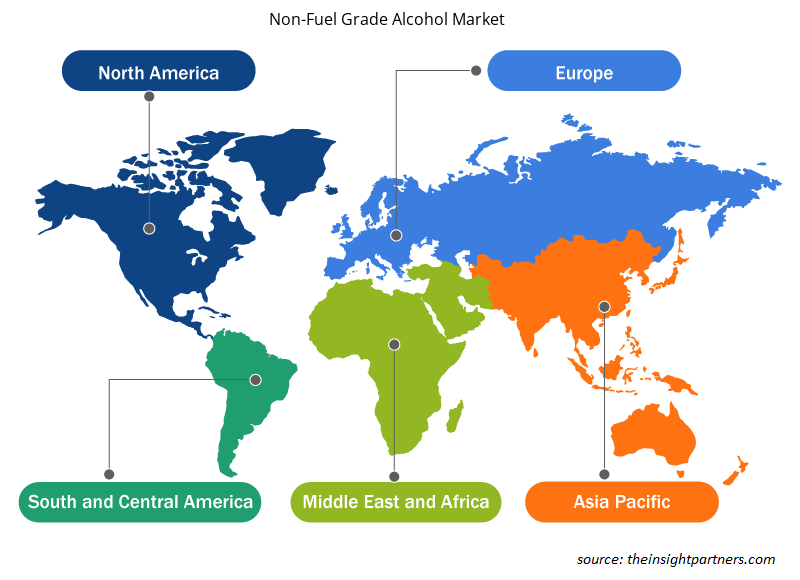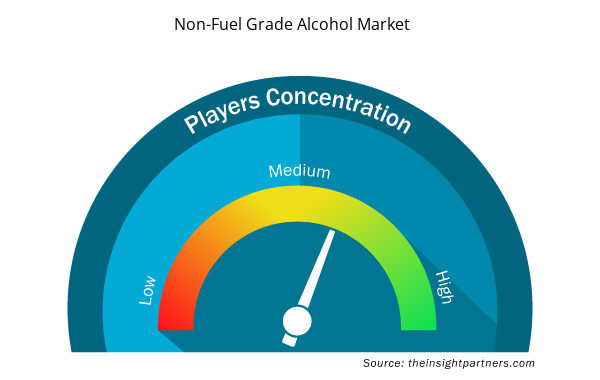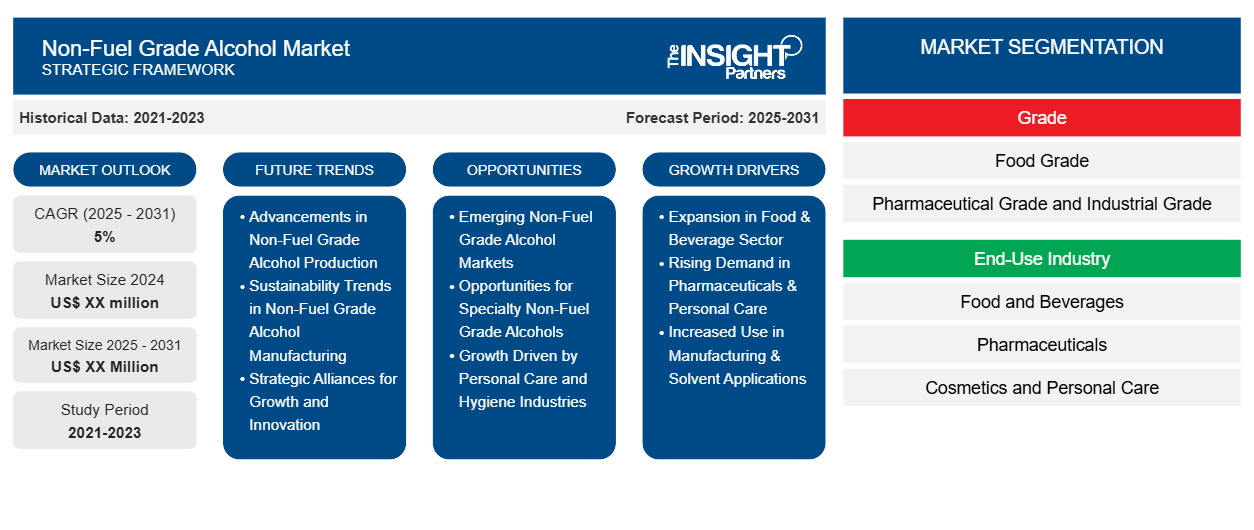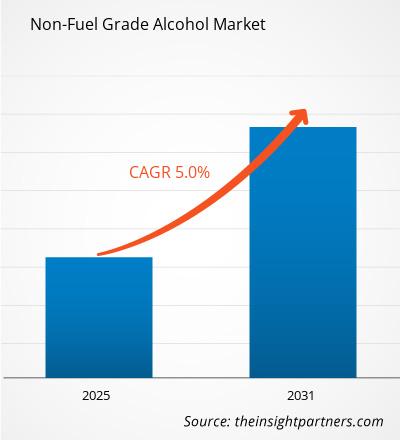Es wird erwartet, dass der Markt für alkoholische Getränke ohne Kraftstoffqualität von 2024 bis 2031 eine durchschnittliche jährliche Wachstumsrate (CAGR) von 5 % verzeichnet, wobei die Marktgröße von XX Millionen US-Dollar im Jahr 2024 auf XX Millionen US-Dollar im Jahr 2031 anwachsen wird.
Der Bericht ist nach Qualität (Lebensmittelqualität, pharmazeutische Qualität und Industriequalität) segmentiert. Der Bericht präsentiert außerdem Analysen basierend auf der Endverbrauchsbranche (Lebensmittel und Getränke, Pharmazeutika, Kosmetik und Körperpflege, Chemikalien und andere). Die globale Analyse ist weiter auf regionaler Ebene und in die wichtigsten Länder unterteilt. Die Marktgröße und -prognose auf globaler, regionaler und Länderebene für alle wichtigen Marktsegmente werden im Rahmen des Berichts abgedeckt. Der Bericht bietet den Wert in USD für die oben genannte Analyse und die Segmente. Der Bericht bietet wichtige Statistiken zum Marktstatus der wichtigsten Marktteilnehmer und bietet Markttrends und -chancen.
Zweck des Berichts
Der Bericht „Non-Fuel Grade Alcohol Market“ von The Insight Partners soll die aktuelle Situation und das zukünftige Wachstum sowie die wichtigsten treibenden Faktoren, Herausforderungen und Chancen beschreiben. Dies wird verschiedenen Geschäftspartnern Einblicke geben, wie zum Beispiel:
- Technologieanbieter/-hersteller: Um die sich entwickelnde Marktdynamik zu verstehen und die potenziellen Wachstumschancen zu kennen, damit sie fundierte strategische Entscheidungen treffen können.
- Investoren: Durchführung einer umfassenden Trendanalyse hinsichtlich der Marktwachstumsrate, der finanziellen Marktprognosen und der Chancen entlang der Wertschöpfungskette.
- Regulierungsbehörden: Zur Regulierung von Richtlinien und Überwachungsaktivitäten auf dem Markt mit dem Ziel, Missbrauch zu minimieren, das Vertrauen der Anleger zu bewahren und die Integrität und Stabilität des Marktes aufrechtzuerhalten.
Marktsegmentierung für nicht brennbaren Alkohol
Grad
- Lebensmittelqualität
- Pharmazeutische Qualität und Industriequalität
Endverbrauchsindustrie
- Essen und Trinken
- Pharmazeutika
- Kosmetik und Körperpflege
- Chemikalien und Sonstiges
Passen Sie diesen Bericht Ihren Anforderungen an
Sie erhalten kostenlose Anpassungen an jedem Bericht, einschließlich Teilen dieses Berichts oder einer Analyse auf Länderebene, eines Excel-Datenpakets sowie tolle Angebote und Rabatte für Start-ups und Universitäten.
- Holen Sie sich die wichtigsten Markttrends aus diesem Bericht.Dieses KOSTENLOSE Beispiel umfasst eine Datenanalyse von Markttrends bis hin zu Schätzungen und Prognosen.
Wachstumstreiber auf dem Markt für nicht brennbaren Alkohol
- Expansion im Lebensmittel- und Getränkesektor: Der zunehmende Alkoholkonsum im Lebensmittel- und Getränkesektor ist weiterhin einer der wichtigsten Faktoren, die das Wachstum des Marktes für nicht als Kraftstoff erhältlichen Alkohol antreiben. Ethanol ist ein wichtiger nicht als Kraftstoff erhältlicher Alkohol, der in der Lebensmittelverarbeitung häufig als Konservierungsmittel, Geschmacksstoff und Lösungsmittel verwendet wird. Das Know-how bei Craft-Getränken und die Verfügbarkeit von hochwertigem Ready-to-Drink (RTD) – oft mit Alkohol und Spirituosen gemischt – erhöhen die Nachfrage nach nicht als Kraftstoff erhältlichem Alkohol von hoher Qualität.RTD)-often blended in alcohol and spirituous flavored liquors-increasing demand for non-fuel grade alcohol of high standards.
- Steigende Nachfrage in den Bereichen Pharmazeutika und Körperpflege: Eine weitere Kategorie von nicht als Kraftstoff geeigneten Alkoholen, in der Ethanol und Isopropylalkohol am häufigsten verwendet werden, sind Pharmazeutika und Körperpflegeprodukte. Die Alkohole sind in Reinigungsmitteln, Lösungsmitteln und auch zur Desinfektion enthalten. Der globale Rohstoffmarkt wurde durch die Einführung von Gesundheitsmaßnahmen zur Gewährleistung der Sicherheit aufgrund von Pandemien wie COVID-19 verändert, da die Menschen gesunde Hygienestandards einhalten und den Verbrauch von Desinfektionsmitteln erhöhen. Dieser Trend wird sich wahrscheinlich fortsetzen, wenn man berücksichtigt, dass nicht als Kraftstoff geeignete Alkohole in der Industrie verwendet werden, was zu einer weiteren Nachfrage führt.
- Verstärkter Einsatz in der Fertigung und bei Lösungsmittelanwendungen: Alkoholische Lösungsmittel, die nicht für Kraftstoffe geeignet sind, sind in allen Anlagen unverzichtbar, einschließlich Beschichtungen, Klebstoffen oder sogar Reinigungsmitteln. Mit dem Wachstum des Fertigungssegments in sich schnell entwickelnden Ländern steigt der Lösungsmittelverbrauch, was auch dem Markt für Alkohole, die nicht für Kraftstoffe geeignet sind, zugutekommt. Da sich die Produktionsmethoden mit neuen Techniken und Maschinen verändern, um die Produktion zu maximieren, wird sich auch die Verwendung von Alkoholen, die nicht für Kraftstoffe geeignet sind, in Fertigungsprozessen verändern.
Zukünftige Trends auf dem Markt für nicht brennbaren Alkohol
- Fortschritte bei der Produktion von nicht als Kraftstoff erhältlichem Alkohol: Die Effizienz und Nachhaltigkeit der Produktion von nicht als Kraftstoff erhältlichen alkoholischen Getränken haben sich dank neuester Technologien deutlich verbessert. Bei der Produktion von Ethanol und anderen Alkoholarten wurde die Optimierung der Gärung und die Verwendung anderer biochemischer Prozesse übernommen. Diese Technologien zielen darauf ab, die Produktionskosten zu senken und die negativen Auswirkungen der mit der Produktion verbundenen Umweltverschmutzung auf den Ablauf der Verfahren zu verringern, ein Trend in der modernen Gesellschaft hinsichtlich Nachhaltigkeitsfragen in der chemischen Industrie.
- Nachhaltigkeitstrends bei der Herstellung von nicht als Kraftstoff geeignetem Alkohol: Das Bemühen um Nachhaltigkeit bei der Herstellung und dem Verkauf von nicht als Kraftstoff geeignetem Alkohol ist auf dem aktuellen Markt spürbar. Immer mehr Unternehmen wenden sich Methoden der Alkoholherstellung zu, bei denen Rohstoffe aus Pflanzen verwendet und anderer Alkohol recycelt wird. Der Grund für die Verlagerung des Marktes hin zu dieser nachhaltigeren Alkoholversorgung liegt in der Nachfrage der Verbraucher nach umweltfreundlichen Lösungen und in Vorschriften zur Begrenzung der Emission von Treibhausgasen. Diese Marktverlagerungen in Verbindung mit nachhaltigen Praktiken bei der Einführung umweltfreundlicher Herstellungsverfahren werden einige Hersteller an die Spitze dieses Marktes katapultieren.
- Strategische Allianzen für Wachstum und Innovation: Akteure auf dem Markt für nicht als Kraftstoff geeignete Alkohole gehen strategische Allianzen ein, um ihre Produkte und Dienstleistungen zu verbessern und ihre Präsenz zu erhöhen. Strategische Partnerschaften zwischen Alkoholherstellern, Technologieunternehmen und Forschungseinrichtungen fördern die Entwicklung und schaffen neue Märkte für nicht als Kraftstoff geeignete Alkohole. Diese Strategien helfen dabei, in einem Geschäftsumfeld, das von schnellen technologischen Veränderungen geprägt ist, relevant zu bleiben.
Marktchancen für Alkohol ohne Kraftstoffqualität
- Neue Märkte für nicht brennbaren Alkohol: Neue Märkte für nicht brennbaren Alkohol entstehen in Ländern wie dem asiatisch-pazifischen Raum und Lateinamerika, die großes Wachstumspotenzial haben. Diese Regionen schrecken vor zu starkem Wirtschaftswachstum und Industrialisierung zurück, doch wenn dies geschieht, wird erwartet, dass die nicht brennbaren Alkohole in alle anderen Bereiche vordringen, in denen sie verwendet werden, und somit die Nachfrage nach ihnen steigen wird. Die Expansion wird von den Unternehmen erlebt, die in der Lage sind, die Nachfrage in diesen Märkten zu finden und ihr Produkt zu lokalisieren.
- Chancen für Spezialalkohole ohne Kraftstoffqualität: Für Hersteller ergeben sich zahlreiche Möglichkeiten durch Spezialalkohole ohne Kraftstoffqualität, die für bestimmte Anwendungen geeignet sind. Beispielsweise kann man in den Markt einsteigen, indem man hochreine Alkohole für die Pharmaindustrie oder einzigartige Alkoholstrukturen für bestimmte industrielle Anwendungen sucht. Passen Sie die Produkte entsprechend den unterschiedlichen industriellen Anforderungen an, und Sie können einen größeren Markt erschließen und Ihre Gewinne steigern.
- Wachstumstreiber sind die Körperpflege- und Hygienebranche: Das Wachstum der Körperpflege- und Hygienebranche schafft attraktive Aussichten für den Markt für nicht als Kraftstoff erhältliche Alkohole. Der Bedarf auf dem Markt für Produkte wie Handdesinfektionsmittel und Desinfektionsmittel schafft Raum für Hersteller, sich mit neuen Strategien den nicht als Kraftstoff erhältlichen Alkoholen zuzuwenden, um sie in den Produkten zu verwenden. Dies wird den Bedarf an der Produktion dieser in diesem Segment hergestellten Produkte steigern, da die Erwartungen der Kunden hinsichtlich Wirksamkeit und Sicherheit nicht beeinträchtigt werden.
Regionale Einblicke in den Markt für nicht brennbaren Alkohol
Die regionalen Trends und Faktoren, die den Markt für nicht brennbaren Alkohol während des gesamten Prognosezeitraums beeinflussen, wurden von den Analysten von Insight Partners ausführlich erläutert. In diesem Abschnitt werden auch Marktsegmente und Geografie für nicht brennbaren Alkohol in Nordamerika, Europa, im asiatisch-pazifischen Raum, im Nahen Osten und Afrika sowie in Süd- und Mittelamerika erörtert.

- Erhalten Sie regionale Daten zum Markt für nicht als Kraftstoff erhältlichen Alkohol
Umfang des Marktberichts über nicht brennbaren Alkohol
| Berichtsattribut | Details |
|---|---|
| Marktgröße im Jahr 2024 | XX Millionen US-Dollar |
| Marktgröße bis 2031 | XX Millionen US-Dollar |
| Globale CAGR (2025 - 2031) | 5 % |
| Historische Daten | 2021-2023 |
| Prognosezeitraum | 2025–2031 |
| Abgedeckte Segmente | Nach Klasse
|
| Abgedeckte Regionen und Länder | Nordamerika
|
| Marktführer und wichtige Unternehmensprofile |
|
Marktteilnehmerdichte für nicht als Kraftstoff erhältlichen Alkohol: Die Auswirkungen auf die Geschäftsdynamik verstehen
Der Markt für nicht brennbaren Alkohol wächst rasant, angetrieben durch die steigende Endverbrauchernachfrage aufgrund von Faktoren wie sich entwickelnden Verbraucherpräferenzen, technologischen Fortschritten und einem größeren Bewusstsein für die Vorteile des Produkts. Mit steigender Nachfrage erweitern Unternehmen ihr Angebot, entwickeln Innovationen, um die Bedürfnisse der Verbraucher zu erfüllen, und nutzen neue Trends, was das Marktwachstum weiter ankurbelt.
Die Marktteilnehmerdichte bezieht sich auf die Verteilung von Firmen oder Unternehmen, die in einem bestimmten Markt oder einer bestimmten Branche tätig sind. Sie gibt an, wie viele Wettbewerber (Marktteilnehmer) in einem bestimmten Marktraum im Verhältnis zu seiner Größe oder seinem gesamten Marktwert präsent sind.
Die wichtigsten Unternehmen auf dem Markt für alkoholische Getränke ohne Kraftstoffqualität sind:
- Archer Daniels Midl und Company
- Cargill, Incorporated
- CropEnergies AG
- Godavari Biorefineries Ltd
- LyondellBasell Industries Holdings BV
Haftungsausschluss : Die oben aufgeführten Unternehmen sind nicht in einer bestimmten Reihenfolge aufgeführt.

- Überblick über die wichtigsten Akteure auf dem Markt für nicht brennbaren Alkohol
Wichtige Verkaufsargumente
- Umfassende Abdeckung: Der Bericht deckt die Analyse von Produkten, Dienstleistungen, Typen und Endbenutzern des Marktes für nicht als Kraftstoff erhältlichen Alkohol umfassend ab und bietet einen ganzheitlichen Überblick.
- Expertenanalyse: Der Bericht basiert auf dem umfassenden Verständnis von Branchenexperten und Analysten.
- Aktuelle Informationen: Der Bericht stellt durch die Abdeckung aktueller Informationen und Datentrends Geschäftsrelevanz sicher.
- Anpassungsoptionen: Dieser Bericht kann angepasst werden, um spezifische Kundenanforderungen zu erfüllen und die Geschäftsstrategien optimal anzupassen.
Der Forschungsbericht zum Markt für nicht brennbaren Alkohol kann daher dabei helfen, die Branchensituation und Wachstumsaussichten zu entschlüsseln und zu verstehen. Obwohl es einige berechtigte Bedenken geben kann, überwiegen die allgemeinen Vorteile dieses Berichts tendenziell die Nachteile.
- Historische Analyse (2 Jahre), Basisjahr, Prognose (7 Jahre) mit CAGR
- PEST- und SWOT-Analyse
- Marktgröße Wert/Volumen – Global, Regional, Land
- Branche und Wettbewerbsumfeld
- Excel-Datensatz



Report Coverage
Revenue forecast, Company Analysis, Industry landscape, Growth factors, and Trends

Segment Covered
This text is related
to segments covered.

Regional Scope
North America, Europe, Asia Pacific, Middle East & Africa, South & Central America

Country Scope
This text is related
to country scope.
Häufig gestellte Fragen
Innovation in production processes is expected to be the key market trends
The report can be delivered in PDF/Word format, we can also share excel data sheet based on request.
On the basis of geography, the non-fuel grade alcohol market is classified into North America, Europe, Asia Pacific, Middle East and Africa, and South and Central America
Archer Daniels Midland Company; Cargill Inc; Lallemand Inc; Green Plains Inc; Godavari Biorefineries Ltd are some of the key players operating in the non-fuel grade alcohol market
Increasing demand in the food and beverage sector is driving the market growth
The Non-Fuel Grade Alcohol Market is estimated to witness a CAGR of 5% from 2023 to 2031
Trends and growth analysis reports related to Chemicals and Materials : READ MORE..
1. Archer Daniels Midl and Company2. Cargill, Incorporated3. CropEnergies AG4. Godavari Biorefineries Ltd5. LyondellBasell Industries Holdings BV6. Merck KGaA7. Pannonia Bio8. Sasol9. Solvay10. Wilmar Bioethanol
The Insight Partners performs research in 4 major stages: Data Collection & Secondary Research, Primary Research, Data Analysis and Data Triangulation & Final Review.
- Data Collection and Secondary Research:
As a market research and consulting firm operating from a decade, we have published and advised several client across the globe. First step for any study will start with an assessment of currently available data and insights from existing reports. Further, historical and current market information is collected from Investor Presentations, Annual Reports, SEC Filings, etc., and other information related to company’s performance and market positioning are gathered from Paid Databases (Factiva, Hoovers, and Reuters) and various other publications available in public domain.
Several associations trade associates, technical forums, institutes, societies and organization are accessed to gain technical as well as market related insights through their publications such as research papers, blogs and press releases related to the studies are referred to get cues about the market. Further, white papers, journals, magazines, and other news articles published in last 3 years are scrutinized and analyzed to understand the current market trends.
- Primary Research:
The primarily interview analysis comprise of data obtained from industry participants interview and answers to survey questions gathered by in-house primary team.
For primary research, interviews are conducted with industry experts/CEOs/Marketing Managers/VPs/Subject Matter Experts from both demand and supply side to get a 360-degree view of the market. The primary team conducts several interviews based on the complexity of the markets to understand the various market trends and dynamics which makes research more credible and precise.
A typical research interview fulfils the following functions:
- Provides first-hand information on the market size, market trends, growth trends, competitive landscape, and outlook
- Validates and strengthens in-house secondary research findings
- Develops the analysis team’s expertise and market understanding
Primary research involves email interactions and telephone interviews for each market, category, segment, and sub-segment across geographies. The participants who typically take part in such a process include, but are not limited to:
- Industry participants: VPs, business development managers, market intelligence managers and national sales managers
- Outside experts: Valuation experts, research analysts and key opinion leaders specializing in the electronics and semiconductor industry.
Below is the breakup of our primary respondents by company, designation, and region:

Once we receive the confirmation from primary research sources or primary respondents, we finalize the base year market estimation and forecast the data as per the macroeconomic and microeconomic factors assessed during data collection.
- Data Analysis:
Once data is validated through both secondary as well as primary respondents, we finalize the market estimations by hypothesis formulation and factor analysis at regional and country level.
- Macro-Economic Factor Analysis:
We analyse macroeconomic indicators such the gross domestic product (GDP), increase in the demand for goods and services across industries, technological advancement, regional economic growth, governmental policies, the influence of COVID-19, PEST analysis, and other aspects. This analysis aids in setting benchmarks for various nations/regions and approximating market splits. Additionally, the general trend of the aforementioned components aid in determining the market's development possibilities.
- Country Level Data:
Various factors that are especially aligned to the country are taken into account to determine the market size for a certain area and country, including the presence of vendors, such as headquarters and offices, the country's GDP, demand patterns, and industry growth. To comprehend the market dynamics for the nation, a number of growth variables, inhibitors, application areas, and current market trends are researched. The aforementioned elements aid in determining the country's overall market's growth potential.
- Company Profile:
The “Table of Contents” is formulated by listing and analyzing more than 25 - 30 companies operating in the market ecosystem across geographies. However, we profile only 10 companies as a standard practice in our syndicate reports. These 10 companies comprise leading, emerging, and regional players. Nonetheless, our analysis is not restricted to the 10 listed companies, we also analyze other companies present in the market to develop a holistic view and understand the prevailing trends. The “Company Profiles” section in the report covers key facts, business description, products & services, financial information, SWOT analysis, and key developments. The financial information presented is extracted from the annual reports and official documents of the publicly listed companies. Upon collecting the information for the sections of respective companies, we verify them via various primary sources and then compile the data in respective company profiles. The company level information helps us in deriving the base number as well as in forecasting the market size.
- Developing Base Number:
Aggregation of sales statistics (2020-2022) and macro-economic factor, and other secondary and primary research insights are utilized to arrive at base number and related market shares for 2022. The data gaps are identified in this step and relevant market data is analyzed, collected from paid primary interviews or databases. On finalizing the base year market size, forecasts are developed on the basis of macro-economic, industry and market growth factors and company level analysis.
- Data Triangulation and Final Review:
The market findings and base year market size calculations are validated from supply as well as demand side. Demand side validations are based on macro-economic factor analysis and benchmarks for respective regions and countries. In case of supply side validations, revenues of major companies are estimated (in case not available) based on industry benchmark, approximate number of employees, product portfolio, and primary interviews revenues are gathered. Further revenue from target product/service segment is assessed to avoid overshooting of market statistics. In case of heavy deviations between supply and demand side values, all thes steps are repeated to achieve synchronization.
We follow an iterative model, wherein we share our research findings with Subject Matter Experts (SME’s) and Key Opinion Leaders (KOLs) until consensus view of the market is not formulated – this model negates any drastic deviation in the opinions of experts. Only validated and universally acceptable research findings are quoted in our reports.
We have important check points that we use to validate our research findings – which we call – data triangulation, where we validate the information, we generate from secondary sources with primary interviews and then we re-validate with our internal data bases and Subject matter experts. This comprehensive model enables us to deliver high quality, reliable data in shortest possible time.


 Holen Sie sich ein kostenloses Muster für diesen Bericht
Holen Sie sich ein kostenloses Muster für diesen Bericht